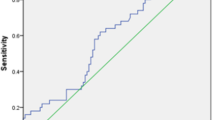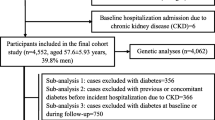Abstract
Purpose This study investigated the cross-sectional association between chronic kidney disease (CKD) and plasma pentraxin 3 (PTX3) levels in a Korean population, in a community-based cohort study.
Methods
A total of 1816 (891 men, 925 women) subjects were randomly selected from the cohort of participants for the final analyses. Plasma PTX3 concentration was determined using enzyme-linked immunosorbent assays. The participants were divided into four quartiles according to the PTX3 levels. Multivariate logistic regression was performed to evaluate the association between plasma PTX3 level and CKD. Covariates inserted into the multivariate model included smoking status, systolic blood pressure, body mass index, waist circumference, high-density lipoprotein, low-density lipoprotein uric acid, white blood cell count, and carotid intima-media thickness.
Results
Compared to the lowest PTX3 group (Q1), a significantly higher risk of CKD was found in the highest group (Q4), with an odds ratio of 1.58 and 95% confidence interval of 1.18–2.11 (P for trend <0.001).
Conclusions
This study showed that higher plasma PTX3 levels are significantly associated with CKD risk. The biological mechanism remains unclear; therefore, further molecular investigation of association between CKD and PTX3 is needed.
Similar content being viewed by others
References
National Kidney F (2002) K/DOQI clinical practice guidelines for chronic kidney disease: evaluation, classification, and stratification. Am J Kidney Dis 39(2 Suppl 1):S1–S266
Mortality GBD, Causes of Death C (2016) Global, regional, and national life expectancy, all-cause mortality, and cause-specific mortality for 249 causes of death, 1980–2015: a systematic analysis for the global burden of disease study 2015. Lancet 388(10053):1459–1544. doi:10.1016/S0140-6736(16)31012-1
Foley RN (2010) Clinical epidemiology of cardiovascular disease in chronic kidney disease. J Ren Care 36(Suppl 1):4–8. doi:10.1111/j.1755-6686.2010.00171.x
Stenvinkel P (2010) Chronic kidney disease: a public health priority and harbinger of premature cardiovascular disease. J Intern Med 268(5):456–467. doi:10.1111/j.1365-2796.2010.02269.x
Kim S, Lim CS, Han DC, Kim GS, Chin HJ, Kim SJ, Cho WY, Kim YH, Kim YS (2009) The prevalence of chronic kidney disease (CKD) and the associated factors to CKD in urban Korea: a population-based cross-sectional epidemiologic study. J Korean Med Sci 24(Suppl):S11–S21. doi:10.3346/jkms.2009.24.S1.S11
Mok Y, Matsushita K, Sang Y, Ballew SH, Grams M, Shin SY, Jee SH, Coresh J (2016) Association of kidney disease measures with cause-specific mortality: the Korean heart study. PLoS ONE 11(4):e0153429. doi:10.1371/journal.pone.0153429
Peri G, Introna M, Corradi D, Iacuitti G, Signorini S, Avanzini F, Pizzetti F, Maggioni AP, Moccetti T, Metra M, Cas LD, Ghezzi P, Sipe JD, Re G, Olivetti G, Mantovani A, Latini R (2000) PTX3, A prototypical long pentraxin, is an early indicator of acute myocardial infarction in humans. Circulation 102(6):636–641
Tong M, Carrero JJ, Qureshi AR, Anderstam B, Heimburger O, Barany P, Axelsson J, Alvestrand A, Stenvinkel P, Lindholm B, Suliman ME (2007) Plasma pentraxin 3 in patients with chronic kidney disease: associations with renal function, protein-energy wasting, cardiovascular disease, and mortality. Clin J Am Soc Nephrol 2(5):889–897. doi:10.2215/CJN.00870207
Dubin R, Li Y, Ix JH, Shlipak MG, Whooley M, Peralta CA (2012) Associations of pentraxin-3 with cardiovascular events, incident heart failure, and mortality among persons with coronary heart disease: data from the heart and soul study. Am Heart J 163(2):274–279. doi:10.1016/j.ahj.2011.11.007
Sun H, Tian J, Xian W, Xie T, Yang X (2015) Pentraxin-3 attenuates renal damage in diabetic nephropathy by promoting M2 macrophage differentiation. Inflammation 38(5):1739–1747. doi:10.1007/s10753-015-0151-z
Sjoberg B, Qureshi AR, Heimburger O, Stenvinkel P, Lind L, Larsson A, Barany P, Arnlov J (2016) Association between levels of pentraxin 3 and incidence of chronic kidney disease in the elderly. J Intern Med 279(2):173–179. doi:10.1111/joim.12411
Meier P (2011) Plasma sTWEAK and PTX3: new determinant tools of cardiovascular outcome also in patients with CKD. Clin J Am Soc Nephrol 6(4):697–699. doi:10.2215/CJN.01490211
Norata GD, Garlanda C, Catapano AL (2010) The long pentraxin PTX3: a modulator of the immunoinflammatory response in atherosclerosis and cardiovascular diseases. Trends Cardiovasc Med 20(2):35–40. doi:10.1016/j.tcm.2010.03.005
Suliman ME, Yilmaz MI, Carrero JJ, Qureshi AR, Saglam M, Ipcioglu OM, Yenicesu M, Tong M, Heimburger O, Barany P, Alvestrand A, Lindholm B, Stenvinkel P (2008) Novel links between the long pentraxin 3, endothelial dysfunction, and albuminuria in early and advanced chronic kidney disease. Clin J Am Soc Nephrol 3(4):976–985. doi:10.2215/CJN.03960907
Yilmaz MI, Axelsson J, Sonmez A, Carrero JJ, Saglam M, Eyileten T, Caglar K, Kirkpantur A, Celik T, Oguz Y, Vural A, Yenicesu M, Lindholm B, Stenvinkel P (2009) Effect of renin angiotensin system blockade on pentraxin 3 levels in type-2 diabetic patients with proteinuria. Clin J Am Soc Nephrol 4(3):535–541. doi:10.2215/CJN.04330808
Simeoni M, Cianfrone P, Comi N, Gentile I, Fabiano FF, Piraina V, Talarico R, Lucisano G, Rivoli L, Andreucci M, Fuiano L, Foti D, Gulletta E, Fuiano G (2015) Is it feasible to improve the duration and the efficiency of Ramipril anti-proteinuric response? G Ital Nefrol 32(1):1–10
Cianfrone P, Simeoni M, Comi N, Piraina V, Talarico R, Cerantonio A, Gentile I, Fabiano FF, Lucisano G, Foti D, Gulletta E, Fuiano G (2017) How to improve duration and efficiency of the antiproteinuric response to Ramipril: RamiPROT-a prospective cohort study. J Nephrol 30(1):95–102. doi:10.1007/s40620-015-0256-3
Kweon SS, Shin MH, Jeong SK, Nam HS, Lee YH, Park KS, Ryu SY, Choi SW, Kim BH, Rhee JA, Zheng W, Choi JS (2014) Cohort profile: the Namwon study and the Dong-gu study. Int J Epidemiol 43(2):558–567. doi:10.1093/ije/dys244
Choi SW, Kim HY, Ahn HR, Lee YH, Kweon SS, Choi JS, Rhee JA, Nam HS, Jeong SK, Park KS, Ryu SY, Song HR, Shin MH (2013) Association of bone mineral density with albuminuria and estimated glomerular filtration rate: the Dong-gu study. Kidney Blood Press Res 37(2–3):132–141. doi:10.1159/000350067
Levey AS, Coresh J, Balk E, Kausz AT, Levin A, Steffes MW, Hogg RJ, Perrone RD, Lau J, Eknoyan G, National Kidney F (2003) National kidney foundation practice guidelines for chronic kidney disease: evaluation, classification, and stratification. Ann Intern Med 139(2):137–147
Touboul PJ, Hennerici MG, Meairs S, Adams H, Amarenco P, Desvarieux M, Ebrahim S, Fatar M, Hernandez RH, Kownator S, Prati P, Rundek T, Taylor A, Bornstein N, Csiba L, Vicaut E, Woo KS, Zannad F, Advisory Board of the 3rd Watching the Risk Symposium 2004, 13th ESC (2004) Mannheim intima-media thickness consensus. Cerebrovasc Dis 18(4):346–349. doi:10.1159/000081812
Touboul PJ, Hennerici MG, Meairs S, Adams H, Amarenco P, Bornstein N, Csiba L, Desvarieux M, Ebrahim S, Fatar M, Hernandez RH, Jaff M, Kownator S, Prati P, Rundek T, Sitzer M, Schminke U, Tardif JC, Taylor A, Vicaut E, Woo KS, Zannad F, Zureik M (2007) Mannheim carotid intima-media thickness consensus (2004–2006). An update on behalf of the advisory board of the 3rd and 4th watching the risk symposium, 13th and 15th European stroke conferences, Mannheim, Germany, 2004, and Brussels, Belgium, 2006. Cerebrovasc Dis 23 (1):75–80. doi:10.1159/000097034
Kweon SS, Lee YH, Shin MH, Choi JS, Rhee JA, Choi SW, Ryu SY, Kim BH, Nam HS, Jeong SK, Park KS (2012) Effects of cumulative smoking exposure and duration of smoking cessation on carotid artery structure. Circ J 76(8):2041–2047
Schiller NB, Shah PM, Crawford M, DeMaria A, Devereux R, Feigenbaum H, Gutgesell H, Reichek N, Sahn D, Schnittger I et al (1989) Recommendations for quantitation of the left ventricle by two-dimensional echocardiography. American society of echocardiography committee on standards, subcommittee on quantitation of two-dimensional echocardiograms. J Am Soc Echocardiogr 2(5):358–367
Inoue K, Sugiyama A, Reid PC, Ito Y, Miyauchi K, Mukai S, Sagara M, Miyamoto K, Satoh H, Kohno I, Kurata T, Ota H, Mantovani A, Hamakubo T, Daida H, Kodama T (2007) Establishment of a high sensitivity plasma assay for human pentraxin 3 as a marker for unstable angina pectoris. Arterioscler Thromb Vasc Biol 27(1):161–167. doi:10.1161/01.ATV.0000252126.48375.d5
Altay S, Cakmak HA, Kemaloglu Oz T, Ozpamuk Karadeniz F, Turer A, Erer HB, Kilic GF, Keles I, Can G, Eren M (2016) Long-term prognostic significance of pentraxin-3 in patients with acute myocardial infarction: 5-year prospective cohort study. Anatol J Cardiol. doi:10.14744/AnatolJCardiol.2016.7307
Tazaki R, Tanigawa J, Fujisaka T, Shibata K, Takeda Y, Ishihara T, Hoshiga M, Hanafusa T, Ishizaka N (2016) Plasma pentraxin 3 level is associated with plaque vulnerability assessed by optical coherence tomography in patients with coronary artery disease. Int Heart J 57(1):18–24. doi:10.1536/ihj.15-248
Jenny NS, Arnold AM, Kuller LH, Tracy RP, Psaty BM (2009) Associations of pentraxin 3 with cardiovascular disease and all-cause death: the cardiovascular health study. Arterioscler Thromb Vasc Biol 29(4):594–599. doi:10.1161/ATVBAHA.108.178947
Witasp A, Ryden M, Carrero JJ, Qureshi AR, Nordfors L, Naslund E, Hammarqvist F, Arefin S, Kublickiene K, Stenvinkel P (2013) Elevated circulating levels and tissue expression of pentraxin 3 in uremia: a reflection of endothelial dysfunction. PLoS ONE 8(5):e63493. doi:10.1371/journal.pone.0063493
Speeckaert MM, Speeckaert R, Carrero JJ, Vanholder R, Delanghe JR (2013) Biology of human pentraxin 3 (PTX3) in acute and chronic kidney disease. J Clin Immunol 33(5):881–890. doi:10.1007/s10875-013-9879-0
Napoleone E, Di Santo A, Bastone A, Peri G, Mantovani A, de Gaetano G, Donati MB, Lorenzet R (2002) Long pentraxin PTX3 upregulates tissue factor expression in human endothelial cells: a novel link between vascular inflammation and clotting activation. Arterioscler Thromb Vasc Biol 22(5):782–787
Yilmaz MI, Sonmez A, Ortiz A, Saglam M, Kilic S, Eyileten T, Caglar K, Oguz Y, Vural A, Cakar M, Egido J, Altun B, Yenicesu M, Blanco-Colio LM, Carrero JJ (2011) Soluble TWEAK and PTX3 in nondialysis CKD patients: impact on endothelial dysfunction and cardiovascular outcomes. Clin J Am Soc Nephrol 6(4):785–792. doi:10.2215/CJN.09231010
Yilmaz MI, Sonmez A, Saglam M, Qureshi AR, Carrero JJ, Caglar K, Eyileten T, Cakir E, Oguz Y, Vural A, Yenicesu M, Lindholm B, Stenvinkel P, Axelsson J (2008) ADMA levels correlate with proteinuria, secondary amyloidosis, and endothelial dysfunction. J Am Soc Nephrol 19(2):388–395. doi:10.1681/ASN.2007040461
Rabbani N, Sebekova K, Sebekova K Jr, Heidland A, Thornalley PJ (2007) Accumulation of free adduct glycation, oxidation, and nitration products follows acute loss of renal function. Kidney Int 72(9):1113–1121. doi:10.1038/sj.ki.5002513
Garlanda C, Bottazzi B, Bastone A, Mantovani A (2005) Pentraxins at the crossroads between innate immunity, inflammation, matrix deposition, and female fertility. Annu Rev Immunol 23:337–366. doi:10.1146/annurev.immunol.23.021704.115756
Ross WR, McGill JB (2006) Epidemiology of obesity and chronic kidney disease. Adv Chronic Kidney Dis 13(4):325–335. doi:10.1053/j.ackd.2006.07.012
Kanbay M, Ikizek M, Solak Y, Selcoki Y, Uysal S, Armutcu F, Eryonucu B, Covic A, Johnson RJ (2011) Uric acid and pentraxin-3 levels are independently associated with coronary artery disease risk in patients with stage 2 and 3 kidney disease. Am J Nephrol 33(4):325–331. doi:10.1159/000324916
Author information
Authors and Affiliations
Corresponding author
Ethics declarations
Conflict of interest
All authors declare that he/she has no conflict of interests regarding the publication of this paper.
Ethical approval
All procedures performed in studies involving human participants were in accordance with the ethical standards of the institutional and national research committee and with the 1964 Helsinki Declaration and its later amendments or comparable ethical standards. This study was approved by Institutional Review Board of Chonnam National University Hospital.
Rights and permissions
About this article
Cite this article
Lee, R., Shin, MH., Kim, HN. et al. Relationship between plasma pentraxin 3 level and risk of chronic kidney disease in the Korean elderly: the Dong-gu study. Int Urol Nephrol 49, 2027–2033 (2017). https://doi.org/10.1007/s11255-017-1662-3
Received:
Accepted:
Published:
Issue Date:
DOI: https://doi.org/10.1007/s11255-017-1662-3




